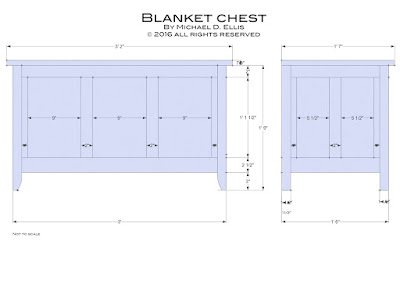The above photo shows a pair of mailboxes I made while working at Portland State University. I made quite a few mailboxes over the years and found them to be a very interesting category of cabinetmaking. When I was first assigned to build a mailbox unit I began to realize what a challenge it would be to produce. These units are made up of 5 verticals dadoed for 15 shelves plus the top and bottom pieces making 60 mail boxes and 2 large shelves. The center verticals are dadoed on both sides. I had to come up with a way to make each dado in the same place from piece to piece. Even a variation of 1/64" over 15 cuts adds up to a half inch difference. The accuracy and precision required were a little daunting to me initially.
I have used a dado set on the table saw with a crosscut sled or sliding table and thought I could use a box jig type setup to register the cuts but it seemed like it could be a bit sloppy and I was concerned that the shelves would not line up. My other option was a router. I sure didn't want to have to set a straight edge for each cut. That would have been worse than using the table saw. So I designed a base for the router that would register off the previous cut and thus maintain a set distance between each dado.
I used a sheet of clear acrylic for the base and added a runner to the bottom (like a miter slot runner), sized to fit the groove produced by the router bit I was using (1/2"). I made the distance between the runner and the bit the distance I wanted between dados. I attached the router firmly to the base and was ready for a test cut. After adjusting the runner to produce the distance between dados I wanted, and adjusting the bit depth I was ready to make some dados.
My first cut had to be done using a straight edge for a guide. After that I could use the jig I had made to run the rest of the grooves. I had previously spent a fair amount of time calculating and laying out the shelves so I could determine the overall dimensions. I actually left the sides long and cut the miters at the top after making all the dados. I also left pieces together when possible, like the two sides, and ripped them apart after dadoing in an attempt to further maintain accuracy. This worked pretty well and I was able to produce a piece both myself and the customer were happy with.
After a while our shop purchased a panel router. With this tool I could make a jig that would register and position my workpiece for each dado. This greatly simplified the machining of all those dados. I could now make identical pieces with relative ease.
Assembling something like this takes some thought. I ended up making a frame to assemble against to hold everything straight and square. With all those dados the pieces were kind of floppy, especially the middle ones! It takes a fair amount of time to glue in all those parts. After all the pieces were glued in I then had to cover the plywood and melamine edges with wood.
The edge banding was glued and clamped with tape. I cut the edging with a chop saw and then planed it to fit using a shooting board.
After the glue is set the tape is removed and the surfaces are leveled and prepped for finishing. Finally, the whole thing is rolled over and a back is glued and nailed on. This makes a very heavy unit with almost a sheet of 3/4" hardwood plywood and about a sheet of 1/2" melamine per unit!

























